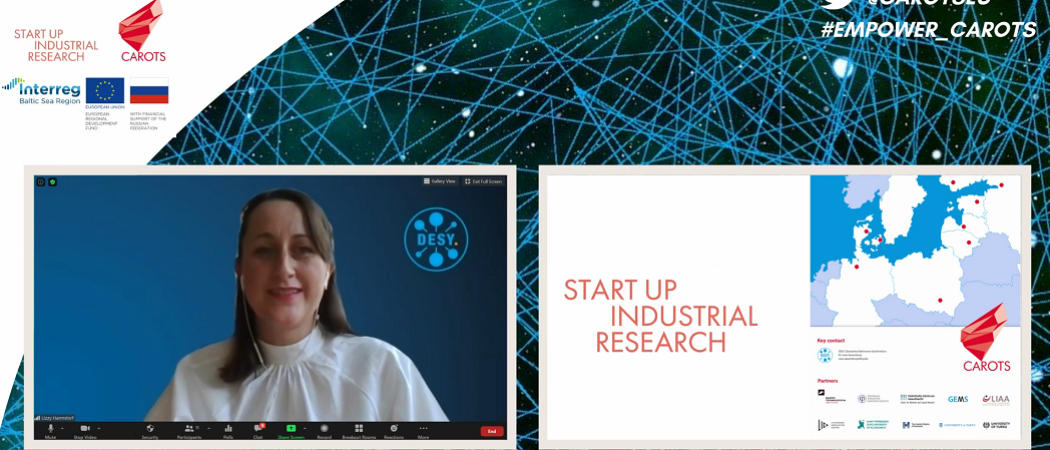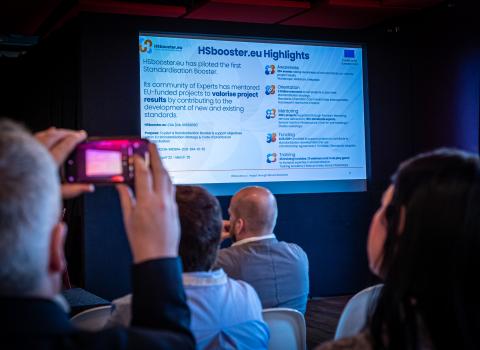Emerging group of intermediaries look to help industry research and test new product concepts

Elizabeth Harmstorf, project manager for market research, innovation & technology transfer, at Deutsches Elektronen-Synchrotron DESY in Hamburg, during the CAROTS conference. Photo: Science|Business.
A new breed of innovation advisors could help companies test their ideas in large research labs across Europe.
So-called commercial analytical research organisations (CAROs) could strengthen ties between scientific research and industry, said stakeholders at the mid-term conference of CAROTS, a project funded by the EU and the Russian Federation to help industry innovate faster by using large research infrastructures more efficiently.
CAROs are for profit companies that give targeted support and advice to companies that need research and measurement services in evolving fields, such as new materials, nanotechnology and life sciences. CAROs could deliver “frequency and robustness of interaction between science and industry,” said Elizabeth Harmstorf, project manager for market research, innovation & technology transfer, at Deutsches Elektronen-Synchrotron DESY in Hamburg. CAROs are very well placed to enhance the relationship between scientific research and industry, she added. “There is a growing demand for expertise.”
CAROs are not just scouting new technologies, but they offer advice on whether scientific results can be translated into a viable product, said Anna Stenstam, CEO of CR Competence AB, one of the CAROs stemming from the Baltic Sea Region. “Even though maybe innovation is really done still by the company, we are coming in from the side and we are trying [to translate] what the [scientific] data means for the business,” said Stenstam.
However, CAROs will need to keep abreast of the instruments and services available from Europe’s many research infrastructures. “It’s extremely important for us to be updated on what can be done at the different sites,” stressed Stenstam.
The EU is tailoring a significant part of Horizon Europe, its next research and innovation programme, around mission-oriented science with a focus on turning scientific discoveries into products faster than before with the help of a new European Innovation Council. The coronavirus pandemic has also highlighted the need for better links between science and industry, as companies and researchers scramble to come up with tests, respirators, therapies and vaccines in a very short period of time.
“A policy instrument targeting CAROs within Horizon Europe would be beneficial,” said Harmstorf. “By fostering CAROs, that enormous expertise that we know already exists in universities, research infrastructures and large research and technology organisations can then be made more available to industrial sectors.”
CAROs offer to pick the right infrastructure and instruments for a project and then process and analyse data. They act as one point of contact between research infrastructures and the industry and liaise on their behalf to bring ideas to the market. “They understand the science part at work, but they also get the commercial content,” said Harmstorf.
Making sense of the research infrastructures
The CAROs could help plug a long-standing gap in the market. Over the past two decades, fewer and fewer companies have retained the skills to translate research results into meaningful product development, according to Ernst Lutz, the president of the European Industrial Research Management Association (EIRMA). While big companies have enough resources to figure out the most efficient ways to conduct their research in cooperation with research infrastructures, small companies may need some help from the outside.
“It becomes much more important now for the medium sized or smaller sized industries to learn how to utilise these infrastructures because [companies] don't have [in-house] capabilities anymore and it's very unlikely that these capabilities will come back,” said Lutz.
As innovation paths are becoming more complex, there is a growing need for intermediaries, he added. More than ever, innovation happens at the interface between a growing number of stakeholders and players. It is less monolithic than when companies were able to come out with innovations based on a research result and then come up with a product that sells well.
“We're facing basically two problems: how to access [research] infrastructures and how to use CAROs to help us solve our problem,” concluded Lutz.
Improving links between research and industry
There are two ways research infrastructures can work with industry, according to Caterina Biscari, director of the ALBA Synchrotron and chair of LEAPS, a consortium of 20 accelerator-based photon sources in 10 European countries.
Companies can either help build custom machines for the large research labs, or they can pay to use them. Intermediaries could step in to help connect scientists, the scientific instrument and the company. “The importance of this collaboration is becoming much more clear,” added Biscari.
At least one third of academic users in ALBA facilities are involved to some degree with industry partners, said Biscari. “We are preparing a strategy to have a stronger, continuous relationship with industry.”
The LEAPS facilities now have tens of thousands of academic users and thousands of industrial users. “This big community is now much more linked than it was before and is also visible to the stakeholders in the national government, and at the level of the European Commission,” Biscari noted.
How CAROs can stay at the cutting edge
In addition to the projects her company is running for academic and industrial clients, Stenstam wants her team to run advanced science projects that will keep them at the frontiers of science. “We are just interested in doing academic science that will keep us on our toes,” said Stenstam. “That is where I’d like to have some public funding.”
According to Stenstam, it is not always immediately obvious whether CAROs can get grant money from public funders. For CR Competence to get such an in-house research project funded by the Swedish research agencies, it would need to prove either academic credentials or a pathway towards a patent or a marketable discovery. “That is a challenge, at least for us,” Stenstam said. She would like to see governments opening up to the idea of funding projects run by CAROs that are eager to keep themselves at the cutting edge of science.
However, as they are not very big companies, CAROs can rarely run more than a few projects in parallel and cash flow is impacted whenever a project runs into a problem. “Our main challenge is to manage to become and stay economically sustainable,” said Bernhard Hesse, CEO of Berlin-based CARO Xploraytion.
During the coronavirus pandemic, some of Xploraytion’s clients paused R&D activities. “If there is a big problem with one of them, it can impact our cash flow,” Hesse said. “We survived this and we are doing okay still, but this is something that is a challenge for a small company.”
A Horizon 2020 grant allowed Finden Ltd., a UK-based CARO, to grow initially, and additional funding from Innovate UK has enabled it to test new ideas for services and get them ready for market. “Grant funding allowed us to overcome the growth hurdle,” managing director Simon Jacques said. Despite the slowdown caused by the pandemic, Finden has been able to continue its projects for large companies that rely on chemical science to optimise their products, he added.
An opening from the EU
Policymakers at the European Commission are still assessing the value of CAROs and how to categorise them among the more traditional types of research support organisations. Another initiative called ATTRACT, which brings large infrastructures together with companies to build the next generation of detection and imaging technologies, has the backing of the Commission.
“I think the CAROs should reach out to the European Innovation Council,” said Johannes Klumpers, head of the research and industrial infrastructures unit at the Commission. “In that field of intermediaries, probably the CAROs have still some work to do, to find their place, and also to make it clear what distinguishes them, what is their additional plus in relation to maybe already existing things.”
To that end, the CAROTS project is creating a network and has formed an advisory committee to help CAROs speak with one voice. The committee now has representatives of policy, science and business from Poland, Estonia, Sweden, Lithuania, and Germany.
Until recently, innovation and technology transfer mostly originated from countries in western Europe. For years, the Commission has been looking at how to boost the R&D performance and innovation capabilities in poorer member states. “Getting [the CAROs] initiative with that strong rooting in the Baltic States is really good,” noted Klumpers.





 A unique international forum for public research organisations and companies to connect their external engagement with strategic interests around their R&D system.
A unique international forum for public research organisations and companies to connect their external engagement with strategic interests around their R&D system.